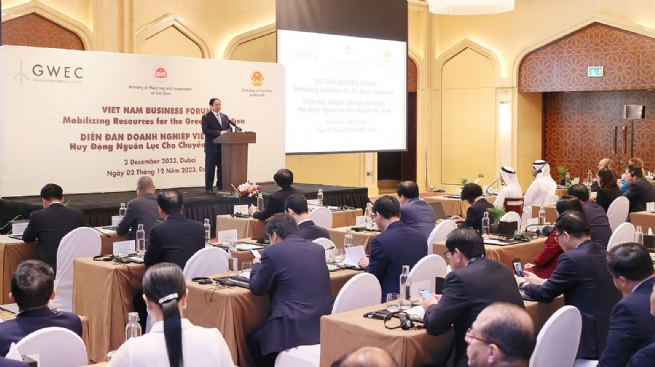COPs, Hydrogen, and Net Zero Journey: From Global Commitments to Vietnam’s Action Plan
From the Conference of the Parties to the United Nations Framework Convention on Climate Change (COP 21) in Paris to COP28 in Dubai, the world has experienced a transformative decade in climate action. Central to this shift is hydrogen, especially green hydrogen, which is emerging as the "technological key" to a new energy era, enabling the achievement of net-zero emissions.
For Vietnam, the Net Zero commitment announced at COP26 is now becoming a concrete action plan, paving the way for green industrial development aligned with the national hydrogen strategy.

During his visit to the UAE for COP28, Prime Minister Pham Minh Chinh attends the Vietnam Business Forum themed “Mobilizing Resources for Green Transformation”
Global momentum for future energy
COPs have served as the world’s premier diplomatic platform for climate policy, shaping the trajectory of global energy transitions. Hydrogen (H₂) has increasingly been recognized as a strategic solution in this shift, addressing sectors that are challenging to decarbonize, such as heavy industry, maritime, aviation, and chemicals. It also acts as a "bridge" between energy production, storage, and transportation, stabilizing renewable energy systems that are weather-dependent.
At COP21 in Paris (2015), the international community agreed to limit global warming to below 1.5°C. By COP26 in Glasgow (2021), hydrogen was identified as a breakthrough solution for hard-to-abate sectors. The turning point came at COP27 in Egypt (2022) and COP28 in Dubai (2023), where hydrogen was officially incorporated into the "Just Energy Transition Pathway," becoming a cornerstone of global climate negotiations. Over 40 countries signed declarations committing to the development of global hydrogen cooperation, with total investment pledges exceeding US$300 billion by 2030. Notably, green hydrogen produced from renewable electricity via water electrolysis is projected to reduce global CO₂ emissions by up to 20% by mid-century.
Currently, more than 45 countries have announced national hydrogen strategies. The European Union aims to produce 10 million tons of green hydrogen annually by 2030. Countries such as Japan, South Korea, Australia, and Saudi Arabia are establishing global Hydrogen Hubs, large-scale centers for hydrogen production, export, and trade.

The Ministry of Industry and Trade’s conference on policies and mechanisms to promote hydrogen development
COPs and Vietnam’s commitments
Vietnam is among the most climate-vulnerable nations, with over 3,200 km of coastline, the Mekong Delta, and millions dependent on agriculture, fisheries, and coastal ecosystems. Active participation in COPs is both a diplomatic action and a national security strategy, seeking international support, policy insights, technology transfer, and investment to transform the economy.
At COP26 in Glasgow (2021), Vietnam committed to achieving net-zero emissions by 2050, turning an international goal into a domestic policy framework. This commitment has shifted national policy from reactive management to proactive emission reduction planning with clear timelines and budgets. Concurrently, Vietnam joined the Just Energy Transition Partnership (JETP), a public-private international mechanism focused on transitioning from coal to clean energy. The initial JETP package committed approximately US$15.5 billion to support large-scale projects, capacity building, and offsetting transition costs. JETP serves as a crucial financial tool to share investment risks in renewable energy, grid infrastructure, and transition-related projects.
Vietnam also joined the Global Methane Pledge, developing an action plan to reduce methane emissions by 30% by 2030. This commitment is significant, as methane has a global warming potential far greater than CO₂ and constitutes a substantial portion of Vietnam’s emissions, particularly in agriculture, solid waste, and oil and gas sectors. Methane reduction measures, such as alternate wetting and drying (AWD) in rice cultivation, landfill gas recovery, and reducing leaks in the oil and gas industry, offer rapid and cost-effective emission cuts.
| COP (Conference of the Parties) refers to the annual meetings of nearly 200 countries under the United Nations Framework Convention on Climate Change (UNFCCC) to discuss and agree on global climate actions. The first COP was held in Berlin, Germany, in 1995. At COP26 in Glasgow (2021), Vietnam and over 150 countries committed to achieving net-zero emissions by 2050. |
From COPs, commitments have been translated into policies: the revised Power Development Plan VIII adjusts the share of renewable energy, and the green growth strategy is being accelerated. Notably, Decision 165/QD-TTg (February 7, 2024) integrated hydrogen into the national energy roadmap, signaling Vietnam’s readiness to leverage industrial tools to achieve net-zero emissions while tapping into renewable energy advantages. These documents reflect a mindset of using international commitments as a "compass" for planning, prioritizing sectors, regions, and projects accordingly.
However, challenges remain in mobilizing sufficient low-cost and sustainable capital. Additionally, establishing a legal framework, standards, and a measurement, reporting, and verification (MRV) system to ensure transparency and traceability, especially for green hydrogen, is crucial. Another issue is ensuring a just transition for coal-dependent regions and affected workers. Furthermore, developing human resources, project management capabilities, and domestic technology is essential. Addressing these risks requires strong alignment between national policies, businesses, and international partners.
Participation in COPs has shifted Vietnam from a phase of "risk identification" to "action orientation" with specific commitments. Success depends on the ability to transform these commitments into feasible policies: completing the legal framework, creating attractive financial mechanisms to attract private capital, developing the MRV system, and ensuring social equity in the transition. If achieved, COP commitments will mark the beginning of a sustainable transformation and clean growth journey for Vietnam.
Achieving net-zero emissions by 2050 is feasible but requires clear policies, coordination among the state, enterprises, and international partners, and a smart capital mobilization strategy. If Vietnam effectively addresses financial mobilization, standardizes the hydrogen market, and accelerates grid infrastructure, the net-zero commitment could transform into an opportunity for green industrialization, enhancing supply chain value and boosting national competitiveness.

Vietnam Australia Hydrogen Workshop - H2 Mobility & Decentralized System
From commitment to action
In the journey toward net-zero emissions, hydrogen is emerging as the "heart" of the global low-carbon economy. According to the International Energy Agency (IEA), to achieve carbon neutrality by 2050, hydrogen production must increase sixfold from current levels, reaching over 500 million tons per year, with two-thirds derived from green hydrogen produced using renewable electricity. Hydrogen is not only a clean fuel but also the only feasible decarbonization solution for sectors like steel, cement, chemicals, maritime, and aviation.
Currently, more than 45 countries have announced national hydrogen strategies, forming H2 Valleys, integrated clusters for hydrogen production, storage, and consumption connected with electricity infrastructure, ports, and industry. The European Union aims to produce 10 million tons of green hydrogen annually by 2030, with an equivalent amount for import, while Japan and South Korea are leading in technical standards and LNG-hydrogen supply chains.
In the United States, the Inflation Reduction Act (IRA, 2022) offers tax incentives up to US$3 per kg for green hydrogen, stimulating numerous gigawatt-scale projects. Saudi Arabia is implementing the US$8.4 billion NEOM Green Hydrogen Project, aiming to export green ammonia to Europe and Asia. According to BloombergNEF, global investment in hydrogen is expected to exceed US$400 billion by 2030, indicating an accelerating clean energy race.
For Vietnam, hydrogen has been institutionalized in Decision 165/QD-TTg. The Ministry of Industry and Trade is finalizing the national hydrogen development strategy through 2050, targeting annual production of 100,000–500,000 tons by 2030 and 10–20 million tons by 2050, prioritizing green hydrogen. Vietnam's greatest advantage lies in abundant renewable energy sources, particularly offshore wind in the Central and Southern regions and solar power in the Central Highlands and South-Central Coast, providing an ideal foundation for large-scale water electrolysis.
Companies such as PetroVietnam, PV Gas, and BCG Energy are researching and preparing pilot green hydrogen projects connected to industrial zones, ports, and transportation. The longer-term goal is to establish national H2 Hubs in Ho Chi Minh City to serve domestic demand and export to markets such as Japan, South Korea, and the EU, regions in need of reliable green hydrogen sources.
Thus, hydrogen becomes a crucial link connecting Vietnam's Net Zero goals with the global community. By effectively leveraging renewable energy advantages, establishing a transparent policy framework, and fostering international cooperation, Vietnam can position itself as a new player in the global green energy map, where hydrogen is not only a clean fuel but also a symbol of a sustainable, independent development strategy deeply integrated into the global Net Zero value chain.








